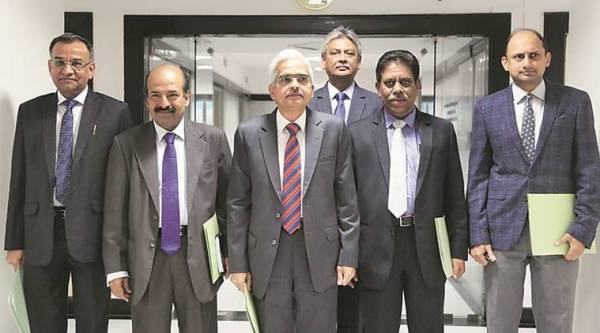
The Reserve Bank of India (RBI) surprised the markets Thursday by reducing its key policy rate — the repo rate — by 25 basis points from 6.50 per cent to 6.25 per cent in the first monetary policy review after new Governor Shaktikanta Das took charge, signalling its intention to focus on growth given the benign outlook on inflation.
The Monetary Policy Committee (MPC), headed by the Governor, also decided to shift the monetary policy stance from ‘calibrated tightening’ to ‘neutral’, indicating that there could be further softening of rates. It was widely expected ahead of Thursday’s meeting that the MPC may leave interest rates unchanged but could move to a ‘neutral’ policy stance.
The decision to change the monetary policy stance was unanimous. But on lowering the repo rate — the rate at which the central bank lends to banks — MPC members Ravindra H Dholakia, Pami Dua, Michael Debabrata Patra and Shaktikanta Das voted in favour while Chetan Ghate and RBI Deputy Governor Viral V Acharya voted to keep the policy rate unchanged.
“It is noteworthy that the path of inflation has moved downwards significantly, and over the period of the next one year, headline inflation is expected to remain contained below or at the target of 4 per cent. This has opened up space for policy action,” Das said after unveiling the policy.
Asked about the transmission of the repo rate cut to customers, Das said, “We will discuss with the banks. It’s for the banks to decide on the lending rates.” Banks are expected to announce a cut in lending rates in the coming weeks. State Bank of India chairman Rajnish Kumar said: “The policy rightfully signals that rates may further soften, going forward, with headline inflation consistently undershooting the RBI inflation mandate and inflation expectations materially down.”
In a significant departure from previous policy reviews, there was emphasis on the need to support growth if inflation objectives are achieved and the MPC noted that slack in the economy is rising. “The favourable macroeconomic configuration that is evolving underscores the need to act now when it is most opportune. In pursuance of the provisions of the RBI Act as amended in 2016, it is vital to act decisively and in a timely manner to address the objective of growth once the objective of price stability as defined in the Act is achieved,” Das said.
Elaborating on the rationale for the the rate cut, the Governor said: “Inflation in items of rural consumption such as firewood and chips, which had remained sticky and at elevated levels, has collapsed in recent months. Electricity prices also showed an unexpected moderation, providing a softer outlook for the fuel group. While inflation excluding food and fuel remains elevated, the recent unusual pick-up in the prices of health and education could be a one-off phenomenon. The crude oil price outlook remains broadly the same as in the December policy.”
According to Das, the shift in the stance of monetary policy from calibrated tightening to neutral also provides flexibility and room to address challenges to sustained growth of the Indian economy over the coming months, as long as the inflation outlook remains benign.
“The decisions of the MPC in this regard will be data driven and in consonance with the primary objective of monetary policy to maintain price stability while keeping in mind the objective of growth,” he said.
The policy panel revised the consumer price inflation downward to 2.8 per cent in the fourth quarter of 2018-19 but projected it to rise to 3.2-3.4 per cent in the first half of 2019-20 and 3.9 per cent in the third quarter 2019-20, with risks broadly balanced around the central trajectory. The RBI also projected a GDP growth of 7.4 per cent — in the range of 7.2-7.4 per cent in the first half — for 2019-20 and 7.5 per cent in the third quarter.
The policy panel also listed several uncertainties and risks. “Vegetable prices have been volatile in the recent period; reversal in vegetable prices could impart upside risk to the food inflation trajectory. Secondly, the oil price outlook continues to be hazy. Thirdly, a further heightening of trade tensions and geo-political uncertainties could also weigh on global growth prospects, dampening global demand and softening global commodity prices, especially oil prices,” the RBI said.
The MPC said the unusual spike in the prices of health and education needs to be closely watched. “Financial markets remain volatile. The monsoon outcome is assumed to be normal; any spatial or temporal variation in rainfall may alter the food inflation outlook,” the MPC said.
“Several proposals in the Union Budget for 2019-20 are likely to boost aggregate demand by raising disposable incomes, but the full effect of some of the measures is likely to materialise over a period of time,” Das said.
He did not make any specific comments on the budgetary measures. The possibility of fiscal slippage has been internalised by the RBI while pencilling in its inflation projections, he said, adding that the farmers income support scheme will improve the disposable income of the farmers.
He said off-budget items are for the fiscal administrators to take care of, while on the public sector borrowing requirement, a public debate has started.
On the issue of paying an interim dividend to the government, Das said: “Payment of surplus or interim dividend to the government is part of the RBI Act, so we are not doing anything beyond what is there in the legal provision.”